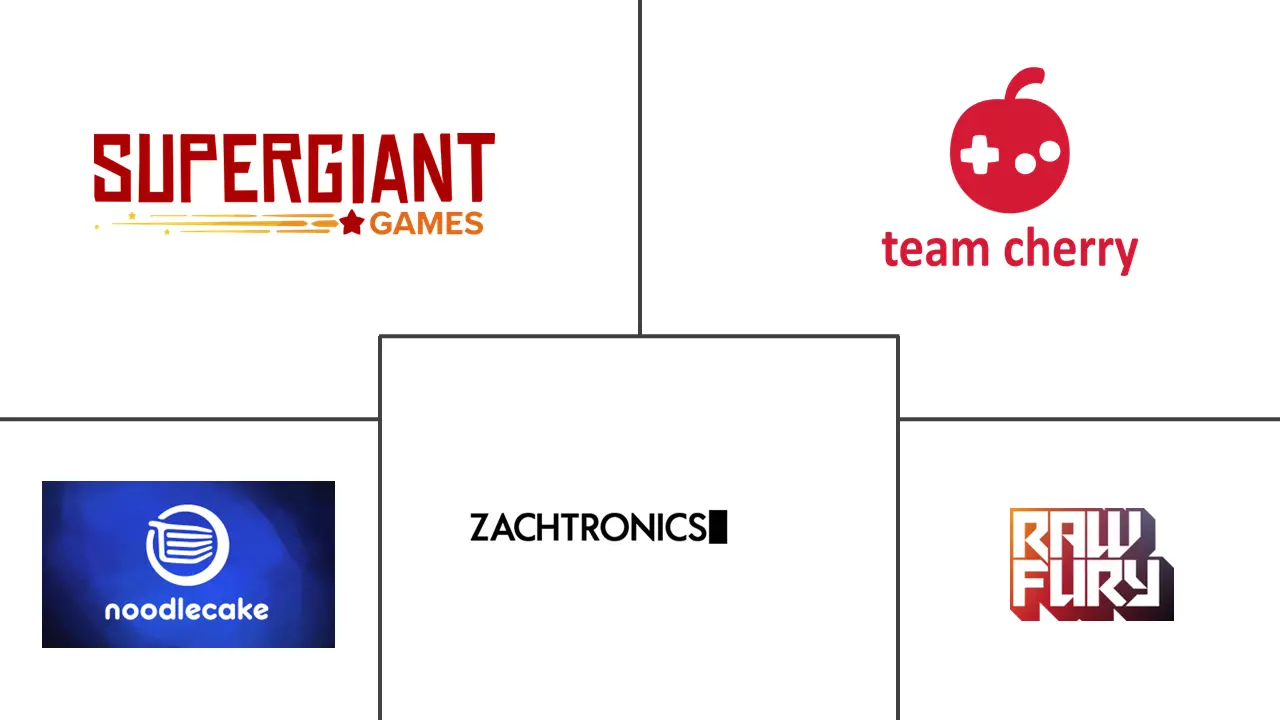Indie Game Market Size and Share
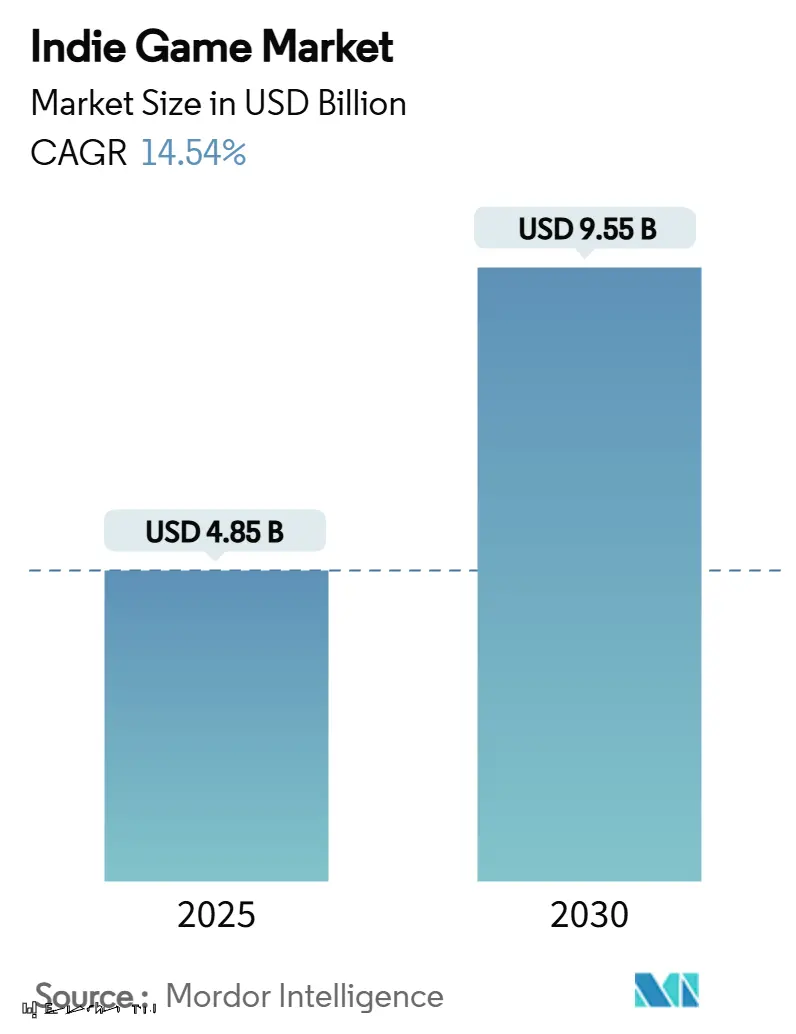
Indie Game Market Analysis by Mordor Intelligence
The indie game market size is estimated at USD 4.85 billion in 2025 and is projected to expand to USD 9.55 billion by 2030 at a 14.54% CAGR. The surge reflects how low-cost engines, generous first-party publishing schemes, and near-frictionless global storefronts are flattening structural barriers for small studios. Mobile platforms have become the primary revenue engine as 5G roll-outs in Latin America and Southeast Asia pull new players into the paid ecosystem. Subscription services are gaining traction, yet one-off premium sales still provide critical day-one cash flow that funds creative risk-taking. Rapid catalog growth on Steam and the App Store signals vibrant supply, but the same abundance amplifies discoverability challenges and marketing cost inflation for newcomers.
Key Report Takeaways
- By device type, mobile commanded 52% of indie game market share in 2024 while recording the fastest 16.8% CAGR through 2030.
- By game genre, action/adventure held 29% revenue share in 2024; simulation and sandbox genres are advancing at a 17.2% CAGR.
- By business model, premium titles retained 61% of the indie game market size in 2024, whereas subscription/season-pass offerings are growing at 22.3% CAGR.
- By distribution channel, digital storefronts captured 92% revenue in 2024; third-party publishing platforms exhibit an 18.5% CAGR outlook.
- By geography, Asia-Pacific generated 45% of 2024 revenue and is set to grow 16.4% annually to 2030.
Global Indie Game Market Trends and Insights
Drivers Impact Analysis
| Driver | (~) % Impact on CAGR Forecast | Geographic Relevance | Impact Timeline |
|---|---|---|---|
| Expanding reach of digital distribution platforms in Asia | +3.2% | APAC core, spill-over to MEA | Medium term (2-4 years) |
| Democratization of game engines and dev-tools | +2.8% | Global | Long term (≥4 years) |
| Cloud-based indie publishing partnerships | +2.1% | North America and EU, expanding to APAC | Medium term (2-4 years) |
| 5G-enabled mobile gameplay in LATAM | +1.9% | Latin America, early adoption in Brazil and Mexico | Short term (≤2 years) |
| Crowdfunding and early-access models | +1.4% | Global, concentrated in North America and EU | Medium term (2-4 years) |
| Government indie-fund programs | +1.1% | North America, Nordics, East Asia | Long term (≥4 years) |
| Source: Mordor Intelligence | |||
Expanding Reach of Digital Distribution Platforms in Asia
Asia-Pacific’s bandwidth upgrades and mobile-first habits are widening the addressable indie audience. The region already houses 1.5 billion active mobile gamers, and alternative carrier-backed storefronts such as dtac’s Gaming Nation are winning creators by taking smaller revenue cuts. [1]Global Games Forum, “Mobile Gaming in APAC: Opportunities and Challenges,” globalgamesforum.com Indonesia’s 96% mobile gaming preference shows how emerging markets bypass consoles entirely. Direct carrier billing lowers payment friction, letting solo studios monetize impulse purchases that credit-card–dependent channels miss. These factors collectively add weight to the indie game market growth outlook as regional storefront competition keeps platform fees under pressure.
Democratization of Game Engines and Dev-Tools
Unity powered 48% of all 2024 Steam releases, proving that easy-to-learn, royalty-free engines shorten time-to-market for small teams. [2]Game World Observer, “How Steam creates opportunities for first-time devs by investing in regional outreach, self-publishing tools, and more,” gameworldobserver.com Unreal Engine’s photoreal toolset is also showing up in higher-fidelity independent productions, while open-source Godot offers zero-royalty freedom. AI-assisted editors further compress iteration cycles, making narrative, art and code chores more approachable for non-technical creators. The widespread tool democratization keeps contributor diversity high and feeds the indie game market with new genres and artistic voices.
Cloud-Based Indie Publishing Partnerships
Microsoft’s ID@Xbox program crossed USD 5 billion in payouts to indie studios, highlighting how platform holders now compete to bankroll independent content. PlayStation’s Partners initiative delivers marketing, QA, and global reach without imposing creative oversight, sidestepping the need for legacy publishers. Because cloud build pipelines compress certification cycles, small teams can hit multiple console storefronts simultaneously—a capability once reserved for AAA budgets. These integrated ecosystems elevate earnings potential and help fortify the indie game market against platform risk concentration.
5G-Enabled Mobile Gameplay Enhancing Engagement in LATAM
Brazil and Mexico are rolling out 5G coverage that lets mid-tier handsets stream high-fidelity titles previously tethered to Wi-Fi. Network improvements unlock real-time multiplayer and cloud gaming, doubling viable playtime windows and pushing average revenue per paying user upward. Early entrants can build brand equity before international giants ramp regional campaigns, boosting lifetime earnings and overall indie game market penetration in Latin America.
Restraints Impact Analysis
| Restraint | (~) % Impact on CAGR Forecast | Geographic Relevance | Impact Timeline |
|---|---|---|---|
| Saturation on key digital marketplaces | -2.4% | Global, most acute in North America and EU | Short term (≤2 years) |
| Discoverability and user-acquisition cost inflation | -1.8% | Global, concentrated in mature markets | Medium term (2-4 years) |
| Limited access to AAA-class marketing budgets | -1.3% | Global | Long term (≥4 years) |
| IP infringement and asset cloning in mobile stores | -0.9% | Global, acute in APAC | Medium term (2-4 years) |
| Source: Mordor Intelligence | |||
Saturation on Key Digital Marketplaces (Steam, App Store)
Steam listed over 14,000 new titles in 2024, diluting storefront visibility and shrinking wishlist-to-sale conversion ratios to 0.125. Algorithms increasingly reward proven engagement, so unlaunched games fight uphill battles against entrenched hits. First-time teams often divert scarce resources to pre-launch marketing, driving costs beyond sustainable levels. The crowding effect slows revenue velocity, tempering indie game market expansion despite robust consumer appetite.
Discoverability and User-Acquisition Cost Inflation
Digital ad auctions now favor deep-pocketed AAA buyers, doubling the customer-acquisition budgets many indies faced just two years earlier. Marketing now consumes 30-50% of total project spend, a sharp leap from the historical 10-20% range. Social platforms throttle organic reach, compelling pay-to-play promotion. Elevated overheads erode break-even prospects, limiting the number of viable new studios and moderating overall indie game market growth potential.
Segment Analysis
By Device Type: Mobile Dominance Drives Cross-Platform Strategy
Mobile’s 52% revenue share underscores how always-connected play aligns with indie design constraints. The segment is forecast to post a 16.8% CAGR, pulling the indie game market size for mobile-first titles toward the USD 5 billion mark by 2030. Nintendo Switch remains a lucrative secondary channel; 45% of households own multiple units, and the family-friendly catalog bias dovetails with indie aesthetics. [3]GameDiscoverCo, “What’s the state of Switch, leading into ‘Switch 2’?” newsletter.gamediscover.co PC is still the default development environment because open storefronts offer higher revenue splits, yet fierce competition reduces average earnings. Console ecosystems bring curated discoverability but entail more compliance overhead and longer certification queues.
Cross-platform engines now allow simultaneous release across PC, console, and mobile without tripling asset budgets. Cloud gaming sidesteps hardware caps, but bandwidth variability hampers adoption in lower-income regions. Success cases such as “Clair Obscur: Expedition 33,” which sold 1.5 million units across three platforms on a sub-USD 30 million budget, showcase scale possibilities. Multiplayer parity and cross-save functions have become baseline consumer expectations, forcing teams to architect networking features early or face negative store reviews.
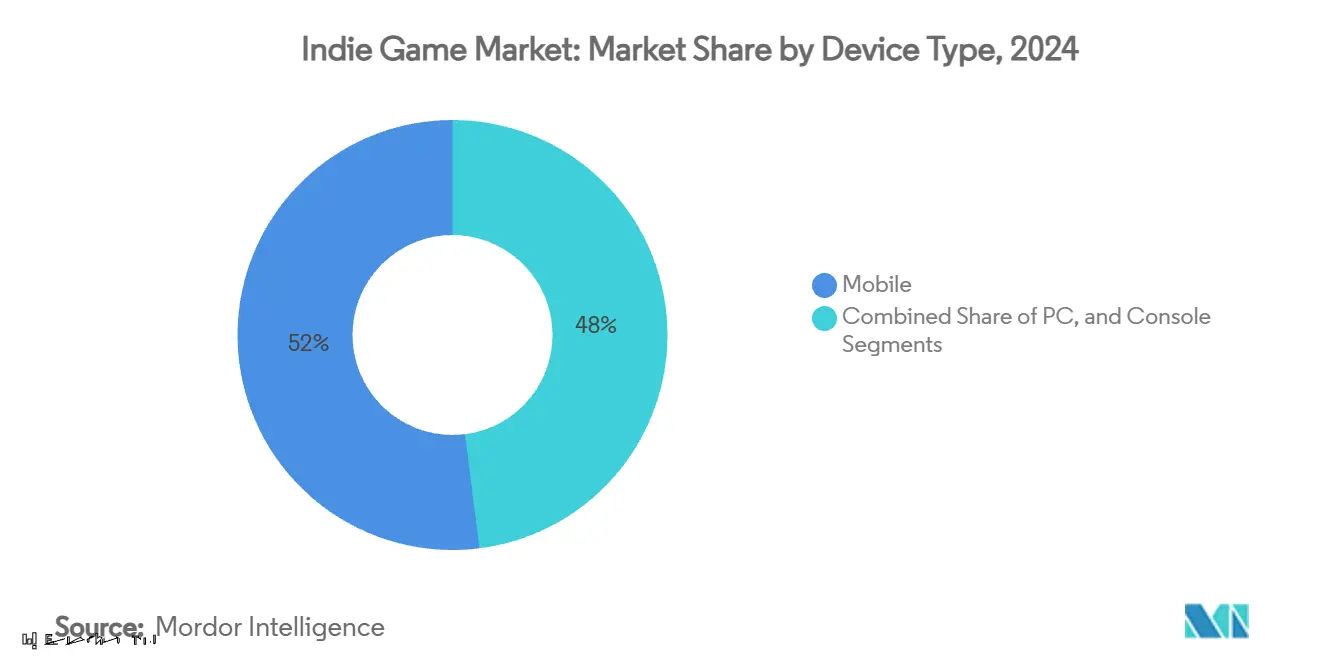
By Game Genre: Simulation Growth Challenges Action Dominance
Action/adventure still commands 29% of 2024 revenue, illustrating player loyalty to skill-based, story-driven gameplay loops. Yet simulation and sandbox titles are climbing at a 17.2% CAGR, reflecting social-creation trends and the economic appeal of user-generated content ecosystems. The indie game market share lead may tilt if simulation growth sustains beyond 2027. Role-playing games attract high-engagement cohorts willing to pay for narrative DLC, offering steady annuity revenue in lieu of blockbuster spikes. Strategy and puzzle niches exhibit lower production costs, allowing micro-studios to survive on modest absolute sales.
Hybrid sub-genres blur boundaries, evidenced by survival-craft hits that merge sandboxes with roguelike progression. Cozy life sims echo wellness and escapism themes, leveraging low-consequence mechanics to appeal to broader demographics. Regional taste skews are pronounced; APAC gravitating to mobile-friendly casual sims, while Western players lean toward story-rich experiences. Such diversity keeps genre experimentation high, reinforcing the creative churn that underpins indie game market resilience.
By Business Model: Premium Resilience Amid Subscription Growth
Premium still accounts for 61% of 2024 revenues, meaning the indie game market size for up-front sales remains the dominant pillar. Subscription and season-pass formats are rising 22.3% annually, capturing long-tail spend by feeding players steady content drops. DLC represents 77% of ongoing in-game spend versus 23% from micro-transactions, confirming that indie audiences prefer meaningful expansions over consumables. Free-to-play remains risky when user-acquisition costs outstrip lifetime value for all but viral hits.
Hybrid monetization is gaining favor: a discounted early-access window funds development, followed by a 1.0 release at premium price and then a cadence of paid expansions. Transparent design around loot-box alternatives pre-empts regulatory headwinds such as the FTC’s COPPA fine on HoYoverse. Expect further convergence as platform subscription catalogs demand day-one indie inclusions while storefronts continue rewarding premium launches with front-page placement.
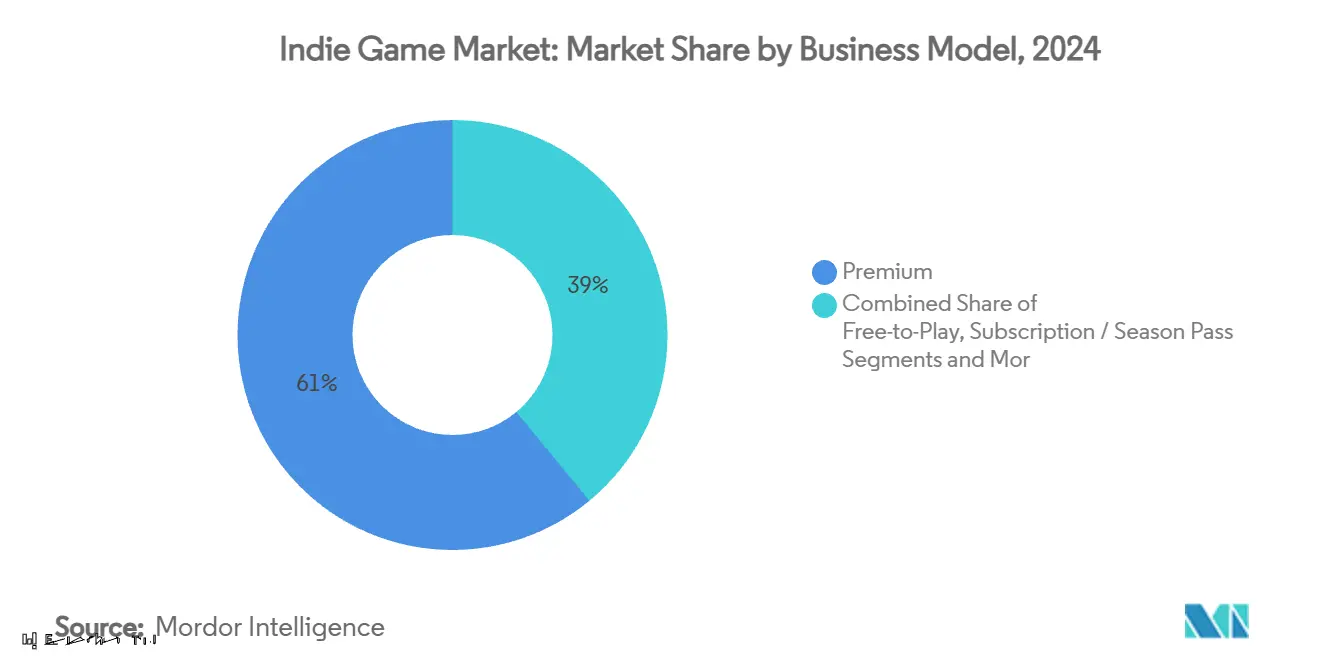
By Distribution Channel: Digital Storefronts Face Platform Diversification
Digital storefronts controlled 92% of 2024 sales, but their dominance is gradually eroding as third-party publishing platforms grow 18.5% annually. Steam remains the gravitational center of PC distribution; over 500 titles grossed above USD 250,000 in month one during 2024. Yet algorithmic discoverability limits uplift for newcomers. Regional platforms in India, Southeast Asia, and the Middle East negotiate lower revenue shares to lure content, broadening the indie game market’s channel mix.
Subscription services such as Xbox Game Pass and PlayStation Plus create another shelf where indies can exchange fixed fees or revenue-share bonuses for predictable cash flows. Direct-to-consumer sales through itch.io or studio websites appeal to communities that prioritize creator support over convenience. Niche physical releases via Limited Run Games monetize collector demand, showing that tactile goods still complement a predominantly digital revenue stack.
Geography Analysis
Asia-Pacific led the indie game market with a 45% revenue share in 2024 and is pacing at 16.4% CAGR. South Korea’s Ministry of Culture earmarked 5 trillion won (USD 3.6 billion) for content industries, handing out grants, tax breaks, and overseas marketing grants that pull indies into global festivals. China’s studios dominate mobile top-grossing charts worldwide, providing collaboration pathways and outsourcing demand that fund smaller regional teams. India represents the fastest-growing gamer base, forecast to add 250 million users by 2030 as smartphone affordability rises.
North America remains the heartbeat for premium indie launches; strong disposable income and console penetration support higher average selling prices. Canada’s tax credits of up to 37.5% of labor costs lower effective burn for Montréal and Vancouver studios. [4]Gouvernement du Québec, “Tax credits for production of multimedia titles | Program Guide 2025,” hellodarwin.com The United States supplies platform HQs, venture funding, and large-scale conventions such as GDC that act as find-a-publisher accelerators. Mexico and Brazil’s 5G expansions fuel mobile-centric revenue, and local payment solutions foster micro-transactions at scale.
Europe benefits from coordinated public funding. Sweden’s game sector generated SEK 34.6 billion (USD 3.2 billion) in 2023, aided by export-oriented tax frameworks. The European Investment Fund’s USD 21 million injection into Behold Ventures widens seed capital for Nordic startups. Germany, France, and the United Kingdom anchor large PC communities and esports ecosystems that provide evergreen demand for indie strategy, sim, and narrative titles. The MENA-3 cluster (Saudi Arabia, UAE, Egypt) produced USD 1.92 billion in 2023 and is slated for USD 2.65 billion by 2027, opening greenfield potential for culturally localized content.
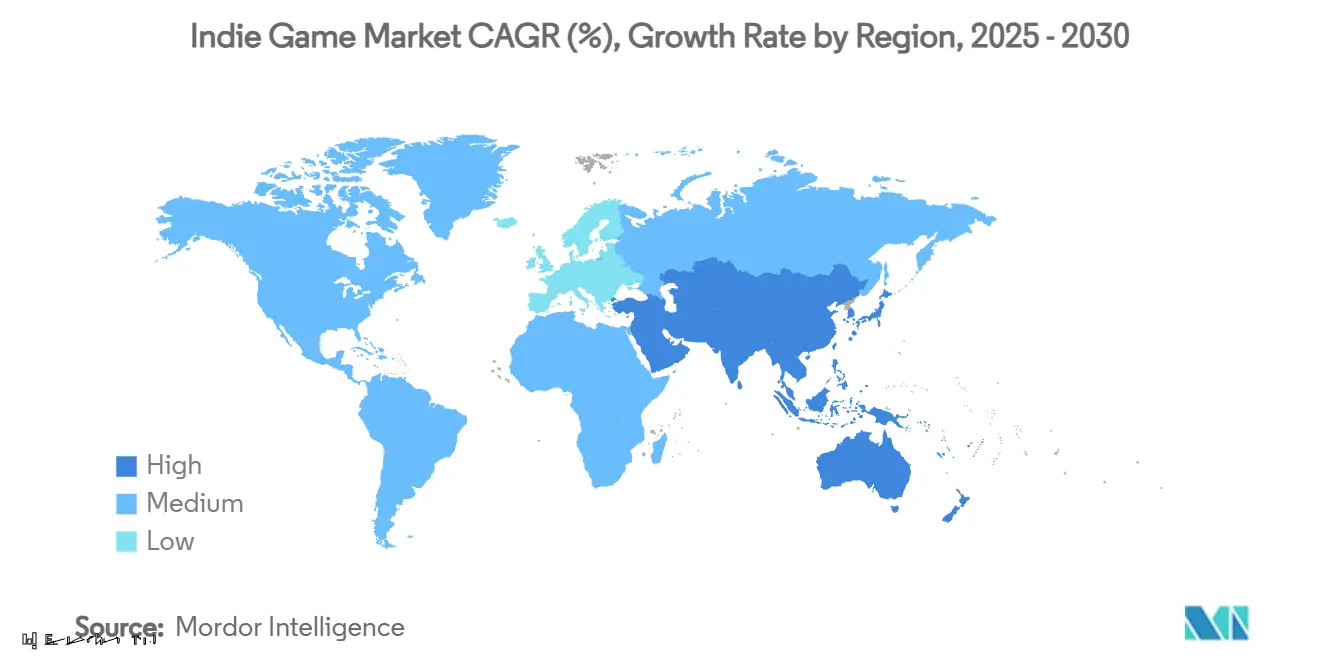
Competitive Landscape
The indie publishing sector is highly fragmented: no single firm holds above 5% revenue, underscoring a fluid playing field where niche specialization outweighs scale economies. Devolver Digital posted USD 104.8 million revenue in 2024, up 13.5%, with 88% sourced from its back catalog. Team17 saw 11% growth to GBP 80.6 million in H1 2024 with 92% from catalog titles. Both illustrate a strategic shift from hit chasing to portfolio management, locking in recurring income streams that cushion new-release volatility.
Technology adoption distinguishes rising publishers. AI-driven asset-localization compresses launch timelines; predictive marketing analytics guide user-acquisition bidding. The “Triple-I” tier—independent studios wielding AAA production values—leverages direct-to-player channels, challenging the need for traditional publisher services. Thunderful Group’s 2024 restructuring cut internal development to double down on third-party publishing, signalling consolidation toward scalable service models.
Regional investors are also stepping in. Krafton’s incubator funds Indian indie teams up to USD 150,000 each, mixing capital with mentorship. Blue Ocean Games created a USD 30 million fund using a revenue-share SAIL model that matches concept risk with upside potential. Kwalee’s minority stake in Devolver signals cross-segment hedging by mobile publishers seeking PC and console upside. These moves intensify competition yet also diversify funding pathways that stimulate indie game market growth.
Indie Game Industry Leaders
-
Supergiant Games, LLC
-
Team Cherry
-
Zachtronics LLC
-
Noodlecake Studios
-
Raw Fury AB
- *Disclaimer: Major Players sorted in no particular order
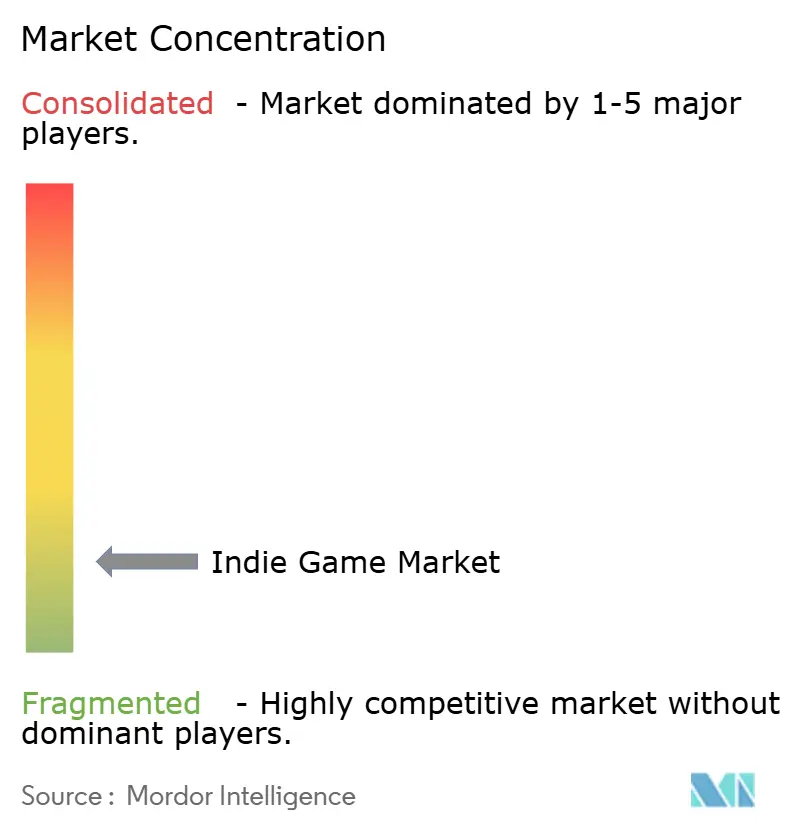
Recent Industry Developments
- June 2025: Nintendo launched the Switch 2 with 13 million units forecast for 2025 and USD 2 billion in software spend, widening the console’s indie addressable base.
- May 2025: Krafton enrolled six studios in its second India Gaming Incubator, offering up to USD 150,000 each.
- April 2025: Blue Ocean Games unveiled a USD 30 million fund to back 100 indie teams over three years.
- March 2025: The European Investment Fund committed USD 21 million to Nordic game development via Behold Ventures.
Global Indie Game Market Report Scope
Indie games, short for "independent video games," are developed by individuals or small teams. These creators operate independently from major studios, both in terms of finances and creative direction.
The study tracks the revenue accrued through the sale of indie games by various players across the globe. The study also tracks the key market parameters, underlying growth influencers, and major vendors operating in the industry, which supports the market estimations and growth rates over the forecast period. The study further analyses the overall impact of COVID-19 aftereffects and other macroeconomic factors on the market. The report’s scope encompasses market sizing and forecasts for the various market segments.
The indie game market is segmented by device type (computer, mobile, and console), type (online and offline), and geography (North America, Europe, Asia Pacific, Middle East & Africa, and Latin America). The market sizes and forecasts regarding value (USD) for all the above segments are provided.
| PC |
| Mobile |
| Console |
| Action / Adventure |
| Role-Playing (RPG) |
| Simulation and Sandbox |
| Strategy and Puzzle |
| Others (Visual Novel, Rhythm) |
| Premium (One-time Purchase) |
| Free-to-Play (IAP/Ads) |
| Subscription / Season Pass |
| Crowdfunded / Early-Access |
| Digital Storefronts (Steam, EGS, Console Stores) |
| Third-Party Publishing Platforms |
| Physical / Collector Editions |
| North America | United States |
| Canada | |
| Mexico | |
| South America | Brazil |
| Argentina | |
| Rest of South America | |
| Europe | Germany |
| United Kingdom | |
| France | |
| Italy | |
| Spain | |
| Rest of Europe | |
| Asia-Pacific | China |
| Japan | |
| South Korea | |
| India | |
| Australia | |
| New Zealand | |
| Rest of Asia-Pacific | |
| Middle East and Africa | United Arab Emirates |
| Saudi Arabia | |
| South Africa | |
| Rest of Middle East and Africa |
| By Device Type | PC | |
| Mobile | ||
| Console | ||
| By Game Genre | Action / Adventure | |
| Role-Playing (RPG) | ||
| Simulation and Sandbox | ||
| Strategy and Puzzle | ||
| Others (Visual Novel, Rhythm) | ||
| By Business Model | Premium (One-time Purchase) | |
| Free-to-Play (IAP/Ads) | ||
| Subscription / Season Pass | ||
| Crowdfunded / Early-Access | ||
| By Distribution Channel | Digital Storefronts (Steam, EGS, Console Stores) | |
| Third-Party Publishing Platforms | ||
| Physical / Collector Editions | ||
| By Geography | North America | United States |
| Canada | ||
| Mexico | ||
| South America | Brazil | |
| Argentina | ||
| Rest of South America | ||
| Europe | Germany | |
| United Kingdom | ||
| France | ||
| Italy | ||
| Spain | ||
| Rest of Europe | ||
| Asia-Pacific | China | |
| Japan | ||
| South Korea | ||
| India | ||
| Australia | ||
| New Zealand | ||
| Rest of Asia-Pacific | ||
| Middle East and Africa | United Arab Emirates | |
| Saudi Arabia | ||
| South Africa | ||
| Rest of Middle East and Africa | ||
Key Questions Answered in the Report
What is the current size of the indie game market?
The indie game market was valued at USD 4.85 billion in 2025 and is forecast to reach USD 9.55 billion by 2030.
Which device segment leads indie game revenue?
Mobile gaming contributed 52% of 2024 revenue and is expanding at a 16.8% CAGR through 2030.
How significant are subscription models for indie games?
Subscription and season-pass monetization is the fastest-growing model at a 22.3% CAGR, although premium sales still generate 61% of revenue.
Which region offers the fastest growth for indie developers?
Asia-Pacific leads with a 45% revenue share and a 16.4% CAGR outlook to 2030, helped by government funding and mobile infrastructure.
What are the main challenges indie studios face?
Storefront saturation and rising user-acquisition costs hamper discoverability, cutting into marketing budgets and elongating the time to break-even.
How fragmented is the competitive landscape?
No single publisher holds more than 5% revenue, giving the market a low concentration score of 2 and ample room for new entrants.
Page last updated on:
